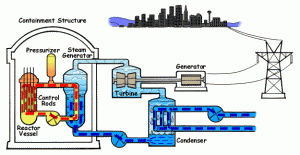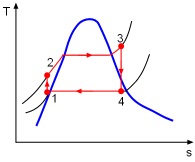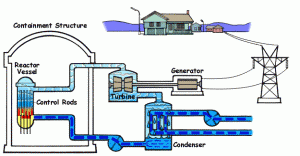How does Nuclear Energy Generate Electricity?
Nuclear power plants operate on the Rankine Cycle. Fission produces heat which creates super-heated steam. The super-heated steam turns a turbine which turns a generator, creating electricity. After the steam exits the turbine, it is condensed in condensed in cooling towers and put back through the cycle. This process of energy generation is virtually the same as all conventional electricity generation because it is using a chemical energy and transferring it into physical energy, thus creating electricity.
Nuclear generation is currently the only source of electricity that has the potential to create a very large baseload very reliably without releasing harmful green house gasses. It has the lowest amount of environmental impact on land and resources while producing the most power.

Source: Nuclear Regulatory Commission
Source: http://www.nrc.gov/reading-rm/basic-ref/students/animated-pwr.html
What is Fission?
Fission a chain chemical reaction that occurs as a result of unstable atoms. Uranium, the fuel of nuclear power plants, is bombarded with neutrons. This causes the Uranium atom to split, and release further neutrons to bombard other Uranium atoms. This split releases an incredible amount of energy in the form of heat.
The alternative of nuclear fission is nuclear fusion. This is a process that instead of breaking atoms to produce energy, atoms are fused to form a larger atom, this is how the sun produces energy.
Source: http://science.howstuffworks.com/nuclear-power1.htm
What is the Rankine Cycle?
The ideal Rankine Cycle consists of four processes:
1-2: Isentropic compression in a pump
2-3: Constant pressure heat addition in a boiler
3-4: Isentropic expansion in a turbine
4-1: Constant pressure heat rejection in a condenser

Source: ECourses.ou.edu
The actual Rankine cycle does not feature completely isentropic compressor nor expansion. There is also a loss in pressure during head addition and rejection due to head loss.
Source: Thermodynamics: An Engineering Approach (7th Edition),
https://ecourses.ou.edu/cgi-bin/ebook.cgi?doc=&topic=th&chap_sec=10.1&page=case_sol
Pressurized Water Reactors vs. Boiling Water Reactors
Pressurized Water Reactors (shown above) contain two water loops. The first water loop goes through the reactor to extract heat from the fission process. This heat is exchanged to a second water loop which enacts the Rankine Cycle.
Boiling water reactors also usually contain two water loops. However the first loop both extracts heat from fission and enacts the Rankine Cycle. The second loop cools the water from the first loop in the condenser via heat exchanger.

Source: Nuclear Regulatory Commission
Source: http://www.nrc.gov/reading-rm/basic-ref/students/animated-pwr.html
Is Nuclear Electricity Efficient?
Nuclear energy is currently not very energy efficient. Approximately 30% of the energy released from fission is converted to electricity. Compared to up to 55% with some coal power plants, this seems inefficient. However, fuel costs make up a relatively small portion of the cost of nuclear power plants. While they are technically relatively inefficient, the cost of nuclear power remains competitive, and the greenhouse gas emissions resulting from nuclear power are far lower than fossil fuels. The main issue is storing the waste fuel. Also in terms of GHG emissions, none are released during the fission process, the only emissions are the result of mining and transportation issues.
Source: http://www.brighthubengineering.com/power-plants/72369-compare-the-efficiency-of-different-power-plants/,
http://www.electrical-efficiency.com/2012/09/nuclear-power-energy-efficiency/
More Types of Reactors?
Pressurized and Boiling Water Reactors are often refered to as “light water reactors”. That means that these reactors use regular water as the medium of heat transfer. Some reactors use “heavy water”, water treated with heavy metals to slow the fission reaction, and allow the transfer of more heat. These “heavy water” reactors are currently less popular than traditional “light water reactors”.
Fast Neutron Reactors are the next step in nuclear reactors. These reactors use a less efficient moderator such as liquid sodium. Liquid sodium is also used in reactors that utilize a new fuel source that can be used, this fuel is thorium. Thorium is a naturally occurring radioactive element that is extremely abundant and can easily be used for nuclear fission with just a few modifications to existing reactors. One bowling ball sized piece of thorium has more energy potential than an oil-transporting super tanker.
In this case, more energy remains in the released neutrons which enables the production of Plutonium-239. This Plutonium 239 can be used as fuel in other nuclear reactors. In fact, some Fast Neutron Reactors create more fuel than is consumed. These are often referred to as “Breeder Reactors”. These reactors are not widely utilized today for fear of nuclear proliferation. Only India, Russia, Japan, and China have live breeder reactors today.
Source: http://www.scientificamerican.com/article/how-do-fast-breeder-react/
Works Cited
- Brain, Marshall, and Robert Lamb. “How Nuclear Power Works.” HowStuffWorks. HowStuffWorks.com, 09 Oct. 2000. Web.
- Cengel, Yunus A., and Michael A. Boles. Thermodynamics: An Engineering Approach. 7th ed. New York: McGraw Hill, 2011. Print.
- Karam, P. A. “How Do Fast Breeder Reactors Differ from Regular Nuclear Power Plants?” Scientific American Global RSS, 17 Jan. 2007. Web. 05 May 2014.
- “Nuclear Power at Core of Energy Efficiency Challenge | Energy 3.0 : The Webmagazine about Energy Efficiency.” Energy-efficiency.com. Energy 3.0: Energy Efficiency Magazine, 7 Sept. 2007. Web. 05 May 2014.
- “The Pressurized Water Reactor (PWR).” NRC:. Nuclear Regulatory Commission, 29 Mar. 2012. Web.
- “Thermodynamics EBook: Ideal Rankine Cycle.” Thermodynamics EBook: Ideal Rankine Cycle. ECourses, n.d. Web. 05 May 2014.
Image
- Zactruba, John. “The Efficiency of Power Plants of Differnt Types.” Brighthub Engineering. BrightHub Engineering, 27 Mar. 2010. Web. 05 May 2014.
Primary Author(s): Zachary Lappen and Austin Luginbuhl
Editor: Matt Pigott